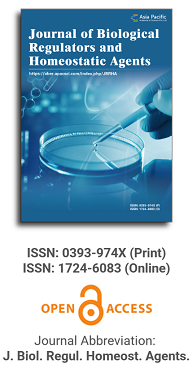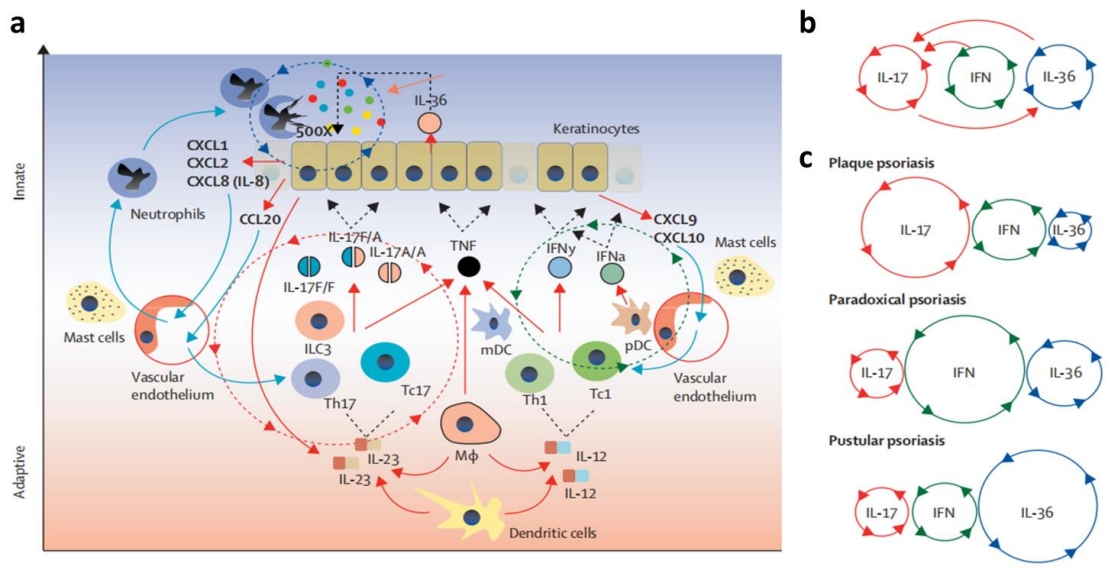
Publication Frequency
Quarterly since 2025
Journal Articles
Search
Search scope
Journal Center
Asia Pacific Academy of Science Pte. Ltd. (APACSCI) specializes in international journal publishing. APACSCI adopts the open access publishing model and provides an important communication bridge for academic groups whose interest fields include engineering, technology, medicine, computer, mathematics, agriculture and forestry, and environment.
Volume Arrangement
2025
Featured Articles

Psoriasis is a common, chronic, and inflammatory skin disease. Macrophages account for about 61.3% of the inflammatory cells infiltrating psoriatic lesions. Modulating macrophage polarization, inhibiting their infiltration, and targeting the secretion of inflammatory factors and associated inflammatory pathways by these cells can alleviate psoriasis symptoms and inflammation. Moreover, nanomaterials as novel drug carriers, offer unique advantages such as large surface area, easy modification, high biocompatibility, good biodegradability, enhanced systemic adsorption, etc. Nanomaterials have great potential for efficient drug delivery and release, as well as improving therapeutic efficacy while reducing adverse effects. By systematically addressing the role of macrophages in psoriasis pathogenesis and the potential of nanomaterials in treating psoriasis through modulating macrophages, this review enhances our understanding of the disease mechanism and holds promise for novel therapeutic breakthroughs and advancements in the future treatment of psoriasis.
by
Lina Sheng, Xiaofei Li
2025,
39(1);
Received: 20 June 2022; Accepted: 30 November 2022; Available online: 16 January 2025;
Issue release: 31 January 2025
Issue release: 31 January 2025
Abstract
Background: It has recently been shown that concomitant medication, such as proton pump inhibitors (PPIs), can modulate the microbiome and has effect on the clinical outcome among advanced-stage cancer patients following immune checkpoint inhibitors (ICIs). Whether such relationship is associative or causative in advanced non-small cell lung cancer (NSCLC) is content of investigation. The current meta-analysis was conducted to explore the impact of proton pump inhibitors (PPIs) on ICIs treatment in NSCLC.
Methods and Materials: The electronic databases were searched until September, 2022. Researches investigating the predictive role of PPIs in NSCLC following ICIs were included. Then, the meta-analysis was aim to reveal the influence of PPI use on survival efficacy.
Results: 8 researches were finally included. For all interested outcomes, the between-study heterogeneity was low. Our results showed that the concomitant PPI use has a negative effect on the survival of NSCLC receiving ICIs. The pooled HRs of progression-free survival (PFS) and overall survival (OS) were HR = 1.33 (95% CI 1.21 to 1.46, p < 0.00001) and HR = 1.46 (95%
CI 1.32 to 1.62, p < 0.00001) when compared to those without PPIs.
Conclusion: The impact of PPI use is related to poor survival efficacy and may attenuate the anti-cancer activity of ICI. The underlying biological mechanisms of the relation between PPI and the efficacy of ICI treatment should be elucidate through further researches.
show more
by
Xiaogang Peng, Chao Zhang, Guangming Xiang, Zheng Gong, Gengyun Sun
2025,
39(1);
Received: 5 October 2022; Accepted: 5 December 2022; Available online: 16 January 2025;
Issue release: 31 January 2025
Issue release: 31 January 2025
Abstract
Background: How long non-coding RNA (lncRNA) functions in cancer biology has attracted extensive attention recently. Various lncRNAs interfere with the advancement of non-small cell lung cancer (NSCLC). This work focused on how lncRNA LINC00174 functions in NSCLC.
Methods: The analysis of LINC00174 expressions in NSCLC was performed with quantitative real-time PCR (qRT-PCR). The multiplication, migration, aggressiveness and apoptosis of NSCLC cells were evaluated by Cell Counting Kit-8 (CCK-8), Transwell assays and Flow cytometry. The binding relationship between LINC00174 and E1A-binding protein p300 (EP300) was verified by RNA immunoprecipitation experiment. The binding of EP300 to the promoter region of the nuclear factor of activated T cells 5 (NFAT5) was detected by dual luciferase reporter gene assay and immunocoprecipitation assay.
Results: The expression of LINC00174 was increased in NSCLC, which impaired the overall survival time in patients with NSCLC. Knocking down LINC00174 curbed the multiplication, migration and aggressiveness of cancer cells and promoted apoptosis. LINC00174 was directly combined with EP300. Knocking down LINC00174 inhibited the binding of EP300 and NFAT5 promoter region, thereby curbing NFAT5 transcription. In addition, NFAT5 overexpression facilitated cancer cell malignancy, which could be reversed by knockdown of LINC00174.
Conclusions: This study indicates that LINC00174 promotes NFAT5 transcription by recruiting the EP300 to NFAT5 promoter region, thereby accelerating the progression of NSCLC.
show more
by
Dengke Fu, Yang Chen, Dongkui Xu
2025,
39(1);
Received: 19 October 2022; Accepted: 28 November 2022; Available online: 16 January 2025;
Issue release: 31 January 2025
Issue release: 31 January 2025
Abstract
Background: The Long noncoding RNAs (lncRNAs) have been recognized as pivotal regulators in the development of colorectal
cancer (CRC). In this study, we aim to evaluate the impact of lncRNA matrilin 1 (MATN1)-Antisense RNA 1 (AS1)/micro RNA
(miRNA, miR)-200c-3p/hyaluronan synthase-2 (HAS-2) axis on CRC cells and in vivo CRC model.
Methods: The expression levels of LncRNA MATN1-AS1 in CRC tissues were assessed utilizing the Gene Expression Profiling
Interactive Analysis (GEPIA) platform. The expressions of LncRNA MATN1-AS1 and miR-200c-3p were validated through
reverse transcription quantitative polymerase chain reaction, while HAS-2 protein and epithelial-mesenchymal transition (EMT)-
related protein expressions were examined using western blot analysis. The enrichment of lncRNA MATN1-AS1 and miR-200c-
3p was evaluated using RNA Binding Protein Immunoprecipitation (RIP). The binding sites between miR-200c-3p and lncRNA
MATN1-AS1 or HAS-2 were predicted by StarBase and confirmed through dual-luciferase reporter assay. Additionally, colony
formation assay was performed to assess CRC cell proliferation. Transwell migration assay and invasion assay were conducted to
evaluate the migratory and invasive abilities of CRC cells. An in vivo model was established by subcutaneous injection in BALB/c
nude mice, while lung metastasis models were created through caudal vein injection. Immunohistochemistry was employed for
the detection of HAS-2 protein in vivo.
Results: The expression of LncRNA MATN1-AS1 was found to be upregulated in both CRC tissues and cells. Subsequently,
dual-luciferase reporter assay was performed to demonstrate the interaction between miR-200c-3p and lncRNA MATN1-AS1,
which was further confirmed by RNA immunoprecipitation (RIP) assay. Suppression of miR-200c-3p rescued low CRC cell
proliferation, migratory and invasive abilities. EMT caused by the knockdown of lncRNA MATN1-AS1. HAS-2 is identified as
a target that is negatively regulated by miR-200c-3p, highlighting a critical interaction within the CRC molecular landscape. As
for in vivo detections, tumor weight and volume were suppressed via the downregulation of lncRNA MATN1-AS1. Additionally,
lncRNA MATN1-AS1 downregulation inhibited lung metastasis and suppressed HAS-2 protein levels.
Conclusion: The MATN1-AS1/miR-200c-3p/HAS-2 axis was shown to regulate CRC cell proliferation, invasiveness, migration,
EMT, and tumorigenesis in vivo.
show more
by
Maimaiti Xiayimaierdan, Jinyong Huang, Chenchen Fan, Feiyu Cai, Zengru Xie
2025,
39(1);
Received: 24 August 2022; Accepted: 16 December 2022; Available online: 16 January 2025;
Issue release: 31 January 2025
Issue release: 31 January 2025
Abstract
Background: Hydrogen peroxide (H2O2) can induce oxidative injury, protein damage and DNA breaks in osteoblasts. The
purpose of this study was to investigate the effect of heme oxygenase-1 (HO-1) on the biological behavior and oxidative stress
damage of H2O2-treated osteoblasts.
Methods: The skull osteoblasts were isolated and divided into three groups: negative control group (without H2O2 or transfection
of HO-1 protein), positive control group (with H2O2 but without transfection of HO-1 protein) and experimental group (with
H2O2 and transfection of HO-1 protein). After 24 h of intervention, the apoptosis, cell proliferation, levels of reactive oxygen
species (ROS), malondialdehyde (MDA) and superoxide dismutase (SOD), protein levels of B-cell lymphoma-2 (Bcl-2), Caspase-3,
Tartrate resistant acid phosphatase (TRAP) and cytokinin (CTK), as well as protein and mRNA levels of bone gla-protein (BGP)
and Runt related transcription factor 2 (Runx2) were detected.
Results: Compared with the negative control group, the positive control group and the experimental group had lower levels of
SOD, lower protein and mRNA expressions of BGP and Runx2, higher cell proliferation inhibition rate, apoptosis rate, levels of
MDA and ROS levels, and protein levels of Bcl-2, Caspase-3, TRAP and CTK after intervention (all p < 0.05). The experimental
group showed the opposite results when comparing with the positive control group (all p < 0.05).
Conclusions: HO-1 can inhibit the oxidative stress damage of osteoblasts induced by H2O2, as well as promote the proliferation
and inhibit the apoptosis of osteoblasts.
show more
by
Na Zhan, Liping Zou, Qin Du
2025,
39(1);
Received: 17 October 2022; Accepted: 29 January 2023; Available online: 16 January 2025;
Issue release: 31 January 2025
Issue release: 31 January 2025
Abstract
Objective: To explore the biological functions and the mechanisms of ETS transcription factor ELK1 (ELK1) in esophageal
squamous cell carcinoma (ESCC) cells.
Methods: ELK1 expression in ESCC samples/cells was analyzed by the UALCAN database. ELK1 mRNA expression in ESCC
tissue samples and cells was detected utilizing quantitative real-time PCR. Cell counting kit-8 method, BrdU assay and Transwell
assays were employed for examining ESCC cell proliferation, migration, and invasion. The PROMO database was adopted to
predict the binding sites of ELK1 and the cyclin-dependent kinase 4 (CDK4) promoter region. The binding status of ELK1 and
CDK4 was predicted and verified by dual-luciferase reporter gene assay and chromatin co-immunoprecipitation qPCR assay.
The effect of ELK1 on CDK4 expression was examined via western blot. The possibly related signaling pathways to CDK4 were
predicted by the gene set enrichment analysis in the LinkedOmics database.
Results: In ESCC tissues and cells, ELK1 was up-regulated and was associated with short survival of patients. Upregulating
ELK1 promoted malignant phenotypes of ESCC cells; ELK1 knockdown exerted the opposite effect. ELK1 bound to the CDK4
promoter region; ELK1 overexpression facilitated CDK4 expression, whereas ELK1 knockdown inhibited CDK4 expression.
CDK4 is enriched in the Wnt signaling pathway, and ELK1 overexpression boosted β-catenin expression.
Conclusion: ELK1 promotes of CDK4 transcription, and activates Wnt/β-catenin pathway, thereby facilitating the ESCC malignant progression.
show more
by
Xuejiao Yang, Dongdong Zhang, Yan Wei, Yulan Zheng
2025,
39(1);
Received: 17 October 2022; Accepted: 9 January 2023; Available online: 16 January 2025;
Issue release: 31 January 2025
Issue release: 31 January 2025
Abstract
Aim: This study is targeted at investigating the effects of Celastrus orbiculatus extract (COE) on non-small cell lung cancer
(NSCLC) cells.
Methods: At 24, 48 and 72 h after different concentrations of COE were applied to treat NSCLC cells, MTT method, 5-Ethynyl-
2′
-deoxyuridine (EdU) assay, Transwell assay and flow cytometry were conducted to explore the effects of COE at different concentrations on the phenotypes of NSCLC cells. The expression of apoptosis-associated proteins and PI3K/AKT/mTOR-associated
proteins were examined via Western blot.
Results: COE inhibited NSCLC cell multiplication, migration and invasion and facilitated the apoptosis, and this effect was dosedependent. Additionally, also in a dose-dependent manner, COE suppressed Bcl-2 expression and facilitated Bax expression.
After COE treatment, the phosphorylation levels of AKT, mTOR and PI3K were noticeably decreased.
Conclusion: COE suppresses the malignancy of NSCLC cells, probably via inhibiting PI3K/AKT/mTOR signaling.
show more
by
Yiwei Zhang, Shaoqing Wang, Feng Gao, Xiaoying Wang, Yurong Sun, Xianyan Wang
2025,
39(1);
Received: 19 September 2022; Accepted: 25 April 2024; Available online: 16 January 2025;
Issue release: 31 January 2025
Issue release: 31 January 2025
Abstract
Background: miRNAs are involved in the process of tumorigenesis and metastasis as tumor suppressor genes or oncogenes. This
work aims to explore the effect of miR-140 in the proliferation and invasion as well as metastasis of gastric cancer cells, as well
as to provide new target for the diagnosis and therapy for gastric cancer.
Methods: miR-140 mimics and miR-140 inhibitors were transfected to the SGC-7901 gastric cancer cells, the expression of miR-
140 and histone deacetylase4 (HDAC4) in human gastric cancer and normal gastric tissues was evaluated by quantitative reverse
transcription-PCR (qRT-PCR), the HDAC4 protein level was evaluated by western blot method. The effects of miR-140 upregulation and downregulation on the invasion and metastasis ability of SGC-7901 cells were investigated by Transwell cell model.
The samples were classified into control group by adding lipofectamine 2000, negative control group by adding miRNA unrelated
sequence and lipofectamine 2000, miRNA up-regulated transfection group by adding miR-140 mimics and lipofectamine 2000
were added, as well as miRNA down-regulated transfection group by adding miR-140 inhibitors and lipofectamine 2000.
Results: The effects of up and down regulation of miR-140 on the invasion and metastasis ability of SGC-7901 cells were determined by Transwell chamber model. The expression of miR-140 in gastric cancer cells was significantly lower than that of normal
gastric tissue (p < 0.05). The invasion and metastasis ability of SGC-7901 cells in miR-140 mimics and miR-140 inhibitor groups
were significantly lower and higher when compared with negative control (NC) and control groups, respectively. HDAC protein
was significant up-expressed in miR-140 inhibitor group when compared with NC and control groups. All these differences were
of statistical significance (p < 0.05).
Conclusion: The expression level of miR-140 are associated with the invasive and metastatic properties of gastric cancer cells,
which may serve as new target for the clinical treatment of gastric cancer.
show more
by
Zhiping Li, Yuxia Liu
2025,
39(1);
Received: 22 November 2022; Accepted: 20 April 2023; Available online: 16 January 2025;
Issue release: 31 January 2025
Issue release: 31 January 2025
Abstract
Background: Lobar pneumonia seriously endangers children’s respiratory tract health and affects their growth and development,
so it is very important to identify pathogenic microorganisms and use appropriate antibiotics early.
Objective: To analyze the significance of pathogenic detection of alveolar lavage fluid in children with lobar pneumonia.
Methods: The clinical data of 80 children with lobar pneumonia who were hospitalized from March 2019 to March 2022 were
analyzed for pathogenic characteristics in bronchoalveolar lavage fluid (BALF) detected by fluorescence quantitative PCR (FQPCR), and serum mycoplasma pneumoniae-specific antibody (MP-IgM) levels were measured by enzyme-linked immunosorbent
assay (ELISA). The differences in clinical lung infections in children with different age groups, mycoplasma pneumoniae (MP)
pneumonia versus non-MP pneumonia, and mixed versus single infections were compared.
Results: There were 15 cases of pathogenic MP infection in the 1–3 years old group, 34 cases of MP infection in the 4–6 years
old group, and 6 cases of pathogenic MP infection in the 7–14 years old group. Statistically significant differences were observed
in the detection rate of MP between each age group (p < 0.001), and the highest MP detection rate was found in the 7–14 years
old group. The differences in the detection rates of single and mixed infections between the age groups did not come up to the
statistical standard (p > 0.05). The mean age of patients with a single infection was slightly older than that of patients with mixed
infection, but no statistical difference was found between the groups (p > 0.05). The duration of disease was shorter than that of
patients with mixed infection, but the difference between the two groups was not statistically significant (p > 0.05). The positive
rate of MP detection in BALF by FQ-PCR (55, 73.75%) was higher than that of serum MP-IgM detection (38, 47.5%).
Conclusion: The detection rate of MP was the highest in children with lobar pneumonia, followed by Streptococcus pneumoniae
(SP) and adenovirus (ADV), and the pathogens of infection varied in different age groups. MP is the main pathogen of most
mixed infections, and mixed infections are more prone to severe or refractory cases. Further studies are required prior to clinical
promotion.
show more
by
Ran Luo, Yanting Liu, Wei Gong, Jian Chen, Chunlei Tian
2025,
39(1);
Received: 11 October 2022; Accepted: 5 January 2023; Available online: 16 January 2025;
Issue release: 31 January 2025
Issue release: 31 January 2025
Abstract
Background: Unsatisfactory prognosis of glioma partly arises from its resistance to temozolomide (TMZ). This work will focus
on whether luteolin sensitize glioma cells to TMZ and explore its regulatory mechanism.
Methods: The viability, cell cycle progression and programmed death of TMZ-resistant glioma cells were evaluated by CCK-8
assay, flow cytometry, and TUNEL assay. Additionally, the cell migration and invasion were examined by Transwell assay. The
expression of PI3K/AKT signaling pathway-related proteins was probed by Western blot. The target genes of luteolin, and those
related to gliomas were identified by bioinformatics.
Results: In vitro experiments suggested that luteolin could impede the malignant biological behaviors including viability and
aggressiveness of TMZ-resistant glioma cells. Bioinformatics analysis implied the target genes of luteolin and glioma were associated with the PI3K/AKT signaling pathway. Luteolin significantly inhibited p-PI3K and p-AKT proteins’ expression in
TMZ-resistant glioma cells.
Conclusion: Luteolin could sensitize TMZ-resistant cells to TMZ, at least partly via modulating the PI3K/AKT signaling.
show more
by
Yu Liu, Songjun Shao, Yu Tan, Shanyu Wang, Peng Zheng, Jing Han, Ying Zhao, Shanshan Rao
2025,
39(1);
Received: 15 November 2024; Accepted: 17 December 2024; Available online: 16 January 2025;
Issue release: 31 January 2025
Issue release: 31 January 2025
Abstract
Background: Pulmonary fibrosis (PF) is a chronic and progressive interstitial lung disease. Histone deacetylases (HDACs) play
a crucial role in the onset and development of PF. Changes in HDACs 1–10 expression levels occur during PF development, and
their specific roles remain unclear. Therefore, we elucidated changes in the gene and protein levels of HDACs 1–10. Furthermore,
we selectively knocked down HDAC2 to explore the molecular mechanism underlying the regulatory role of HDAC2 in epithelialmesenchymal transition (EMT) during the development of PF.
Methods: Lewis lung carcinoma (LLC) cells were stimulated with transforming growth factor-β1 (TGF-β1) (5 ng/mL) to establish
a lung fibrosis cell model. Additionally, C57BL/6 mice received bleomycin through single intratracheal instillation at a 3.5 mg/kg
volume, diluted in 0.7 mL saline. Furthermore, EMT-related gene and protein expression levels were assessed using quantitative
PCR (qPCR) and Western blotting, respectively.
Results: We observed that HDAC2 expression levels were significantly increased in both the in vitro and in vivo PF models.
HDAC2 knockdown significantly decreased the expression levels of fibrosis indicators such as collagen type I (Col-I) and collagen
type IV (Col-IV), and EMT indicator α-smooth muscle actin (α-SMA) was observed. Conversely, it increased the expression
of EMT indicator E-cadherin (E-cad). Hematoxylin and eosin (H&E) and Masso staining revealed that HDAC2 knockdown
substantially reduced the degree of pulmonary fibrosis. These findings suggest that lowering HDAC2 expression inhibits EMT
and reduces PF. Moreover, in a TGF-β1-induced lung fibrosis cell model, HDAC2 knockdown significantly reduced epithelial
growth factor receptor levels, which inhibited mitogen-activated protein kinases (MAPK) signaling and decreased the protein
expression of p38 and c-Jun N-terminal kinase (JNK).
Conclusions: HDAC2 knockdown effectively impedes EMT and diminishes PF severity, impacting the JNK/p38 MAPK signaling
pathway, which may serve an inhibitory function.
show more
by
Cai-Lin Zhu, Wei-Yun Bi, Hong-Tao Li, Zhi-Yong Zhang
2025,
39(1);
Received: 26 October 2022; Accepted: 26 December 2022; Available online: 16 January 2025;
Issue release: 31 January 2025
Issue release: 31 January 2025
Abstract
Background: Esophageal squamous cell carcinoma (ESCC) is a strongly metastatic and fatal cancer. Currently, the mechanisms
underlying the pathogenesis of ESCC are poorly understood. Lysine-specific demethylase 6B (KDM6B) plays a key role in the
occurrence and development of various human diseases, such as cancers, immune diseases and developmental diseases. Studies
have confirmed that KDM6B may exhibit both tumour-suppressive and oncogenic activities in different cancer types. However,
the expression and role of KDM6B in ESCC remain unclear.
Methods: KDM6B expression was analysed using The Cancer Genome Atlas (TCGA) database, and the correlation between
KDM6B mRNA expression and prognosis was analysed. The expression of KDM6B in Eca109 and TE11 ESCC cells and ESCC
tissues was evaluated using immunohistochemical (IHC) and Quantitative Real-time PCR (RT‒qPCR) analyses. In vitro assays
were further performed to reveal the functions and characterize the upstream and downstream regulation of KDM6B expression.
Results: KDM6B was overexpressed in stage T3/T4 as well as N2/N3 ESCC tissues relative to stage T1/T2 and N1/N2 ESCC
tissues, respectively, and this overexpression was linked to worse prognosis of ESCC. Inhibiting KDM6B expression significantly
impaired the proliferation and metastasis of ESCC cells. Lactate dehydrogenase isoform A (LDHA) plays a critical role in tumour
aerobic glycolysis. The expression of LDHA was inhibited in ESCC cells to assess its role in ESCC proliferation. In this study,
KDM6B knockdown suppressed not only LDHA expression but also ESCC cell proliferation.
Conclusions: Based on these results, we speculate that KDM6B might be a novel therapeutic target for ESCC.
show more
by
Lanfeng Zhang, Hongtao Liu, Feng Yuan, Tianchi Chen, Lin Xu, Jingmao Wang, Yancheng Wang, Ziyue Tong
2025,
39(1);
Received: 3 November 2022; Accepted: 15 December 2022; Available online: 16 January 2025;
Issue release: 31 January 2025
Issue release: 31 January 2025
Abstract
Background: This article mainly analyzed the influence of obesity constitution on the failure of cemented total hip replacement.
Methods: By collecting body mass index (BMI) data of patients with hip joint and bone mineral density (BMD) of femur, the age,
gender and number of patients were statistically analyzed, and the influence of body weight on postoperative implant force was
analyzed by finite element method modeling analysis.
Results: Studies have found that obesity and BMI reaching overweight or obesity standards will aggravate the symptoms of hip
patients, and the effects will be different between different genders. The effects of body weight on hip replacement, fracture of
bone cement stem, sinking of prosthesis stem and loosening of bone cement-stem interface were analyzed in detail.
Conclusions: It was proved that BMI had a great correlation with postoperative failure. In addition, the effect of weight loss
drugs on postoperative rehabilitation immune system was discussed.
show more
by
Xueli Yang, Miao Liu, Tao Deng
2025,
39(1);
Received: 1 October 2022; Accepted: 9 November 2022; Available online: 16 January 2025;
Issue release: 31 January 2025
Issue release: 31 January 2025
Abstract
Background: Hepatocellular carcinoma (HCC) is a common human malignancy. In recent years, the study of biomarkers for
HCC progression has become a hot topic. This study focused on identifying the key gene protein Z (PROZ) associated with the
tumorigenesis of HCC by bioinformatics methods, and exploring its function and regulatory mechanism.
Methods: Differentially expressed genes (DEGs) in HCC cells under hypoxia condition and normoxia condition were analyzed
with the data of GSE15366 and GSE41666. The genes associated with the prognosis of HCC patients were analyzed in the
Human Protein Atlas (HPA) database and intersected with hypoxia-related DEGs in HCC to obtain key genes. Gene Expression
Profiling Interactive Analysis database was used to analyze the relationship between expressions of the above key genes in HCC
and the prognosis of patients. The mRNA expression level of PROZ was analyzed by qPCR. Immunohistochemical staining
results of PROZ in HCC were obtained from the HPA database. The cell viability and apoptosis were testified by CCK-8 and
TUNEL methods. The glucose consumption and lactic acid production of cells were also detected. LinkedOmics database was
used to analyze the relevant signaling pathways regulated by PROZ in HCC. Western blot was adopted to detect expressions
of Hexokinase 2 (HK2) protein, cyclin D1 (cyclin B1) and Notch signaling pathway-related proteins including notch receptor 1
(Notch1) and Hes family BHLH transcription factor 1 (Hes1).
Results: PROZ was greatly down-regulated in HCC cells (HepG2 and Hep3B) in hypoxia condition. PROZ overexpression in
HepG2 cell lines inhibited cell proliferation and glycolysis, and promoted apoptosis; PROZ knockdown worked oppositely. In
terms of mechanism, PROZ inhibited the expression levels of cell cycle-related proteins, Notch1 and Hes1.
Conclusions: PROZ inhibits HCC cell proliferation and glycolysis, and promotes apoptosis by inhibiting cell cycle and Notch
signaling pathways. PROZ could be a potential biomarker/therapy target for HCC.
show more
Rhamnazin Inhibits Malignant Progression of ProstateCancer Cells via DPP4/JAK/STAT Signaling Pathway
by
Shouyu Xue, Aimin Geng, Ting Lian
2025,
39(1);
Received: 19 January 2023; Accepted: 7 June 2023; Available online: 16 January 2025;
Issue release: 31 January 2025
Issue release: 31 January 2025
Abstract
Background: Rhamnazin is a natural dimethoxyflavonoid compound and Rhamnazin has been reported to have antitumor activity. This work is performed to study the function of Rhamnazin in prostate cancer (PCa) cells and its mechanism.
Methods: Rhamnazin (20 µM) was used to treat 22Rv1 and C4-2B cells, and the cells treated with dimethyl sulfoxide (DMSO)
were set as the control group. To investigate the role of dipeptidyl peptidase 4 (DPP4) in mediating the biological effects of Rhamnazin, DPP4 overexpression plasmids were transfected into the PCa cell lines. Cell counting kit-8 method was employed to detect
the proliferation; apoptosis and cell cycle were detected by flow cytometry. the target genes of Rhamnazin were predicted in
Traditional Chinese Medicine Systems Pharmacology (TCMSP) database. Gene Ontology and Kyoto Encyclopedia of Genes and
Genomes enrichment analysis of target genes of Rhamnazin was performed using the Database for Annotation, Visualization
and Integrated Discovery (DAVID database). Human Protein Atlas database was utilized to identify genes associated with poor
PCa prognosis. GEPIA database was used to validate the expression and prognosis of DPP4 in PCa. The LinkedOmics database
was used to analyze the signaling pathway related to DPP4 in PCa. Quantitative polymerase chain reaction was performed to
detect DPP4 mRNA levels. Western blot assays were performed to detect the expression levels of DPP4, phosphorylated (p-)
Janus kinase 1 (JAK1) and p-signal transducer and activator of transcription 3 (STAT3).
Results: Functional assays confirmed that Rhamnazin inhibited the proliferation of PCa cells (p < 0.05), and promoted apoptosis
(p < 0.05) and blocked the cell cycle progression (p < 0.05). In addition, Rhamnazin significantly inhibited the expression of DPP4
(p < 0.05), and up-regulating DPP4 reversed the effects of Rhamnazin (p < 0.05). It was further found that DPP4 was associated
with JAK/STAT signaling and Rhamnazin inhibited the expression of p-JAK1 (p < 0.05) and p-STAT3 (p < 0.05) through DPP4.
Conclusion: Rhamnazin has the potential to kill PCa cells via DPP4/JAK/STAT axis.
show more
by
Peng Gao, Qiangxin Zheng, Junqing Gan, Jie Song, Wenting Jia, Jilong Yang
2025,
39(1);
Received: 19 July 2024; Accepted: 2 August 2024; Available online: 16 January 2025;
Issue release: 31 January 2025
Issue release: 31 January 2025
Abstract
Background: Observational studies have reported an association between immune cells and digestive diseases. We sought to
assess the relationship between immune cells and the risk of gastric malignancy by two-way two-sample Mendelian randomisation
(MR) analysis.
Methods: This study used a comprehensive two-sample Mendelian randomisation (MR) analysis to determine the causal relationship between immune cells and gastric malignancy (GC). Based on publicly available genetic data, we explored the causal
relationship between 731 immune cell signatures and GC risk. We performed Mendelian randomisation (MR) analyses using
genetic variants strongly associated with neutrophil, lymphocyte, eosinophil, basophil and monocyte counts as instrumental variables (IVs). Comprehensive sensitivity analyses were used to verify the robustness, heterogeneity and horizontal pleiotropy of
the results.
Results: Two-sample MR analysis revealed that multiple immune cell phenotypes were significantly associated with the risk of
gastric malignancy. Among the phenotypes with low uncorrected p-values, including CD14- CD16- AC (p < 0.001; OR = 0.9730;
95% CI = 0.9598–0.9863); DN (CD4- CD8-) AC (p < 0.001; OR = 1.1483; 95% CI = 1.0607–1.2432); IgD on IgD+ (p < 0.001; OR
= 0.8883; 95% CI = 0.8289–0.9520). Meanwhile, we used Simple mode, Weight median, and Weight mode, all of which led to the
same conclusion. Moreover, in our further analysis, gastric malignancy also had a causal effect on the above immune cell types
when gastric malignancy was used as an exposure factor, and the results were statistically significant.
Conclusion: The study underscores the crucial role of immune cells in GC development, providing key insights for future research. The statistically significant associations between specific immune cell phenotypes and gastric malignancy risk highlight
potential targets for therapeutic interventions aimed at modulating the immune response in GC, thereby opening avenues for
precision medicine approaches in the treatment of this disease.
show more
Editor-in-Chief

Medical Genetics, University of Torino Medical School, Italy
Co-Editor-in-Chief

Department of Biomedical, Surgical and Dental Sciences, University of Milan, Italy
Indexing & Archiving
News & Announcements
2025-02-01
In addition to the first issue that has already been published by the original publisher, there will be four more issues released this year, with scheduled publication dates in March, June, September, and December respectively.
2025-01-21
Starting from Volume 39 Issue 2 (2025), the ownership of Journal of Biological Regulators and Homeostatic Agents (ISSN: 0393-974X (P); 1724-6083 (O)) will be transferred from Biolife Sas to Asia Pacific Academy of Science Pte. Ltd. As of 21 January 2025, authors should make submissions to the new journal system and follow the author guidelines. Asia Pacific Academy of Science Pte. Ltd. will take over the publication of manuscripts being processed.


 Open Access
Open Access